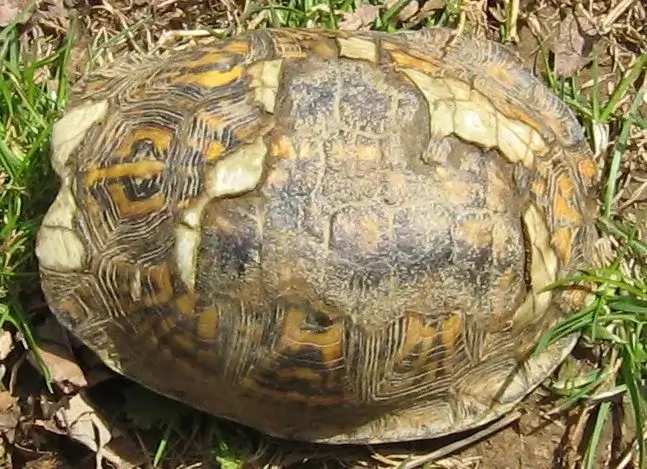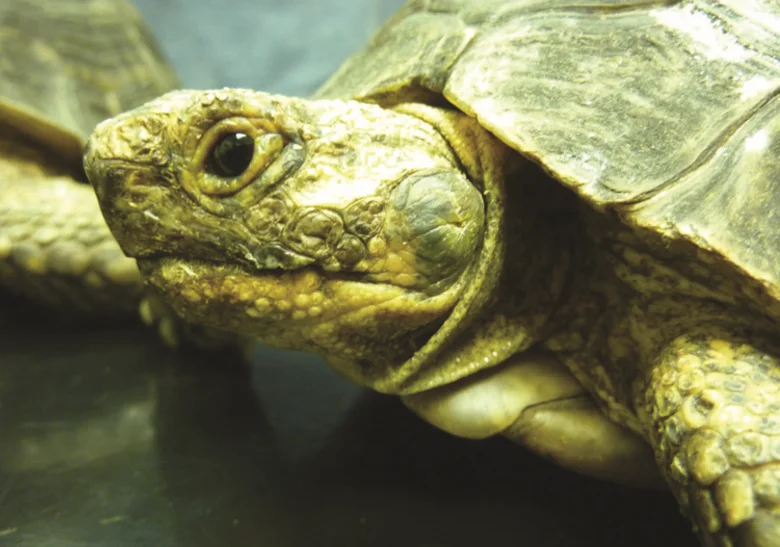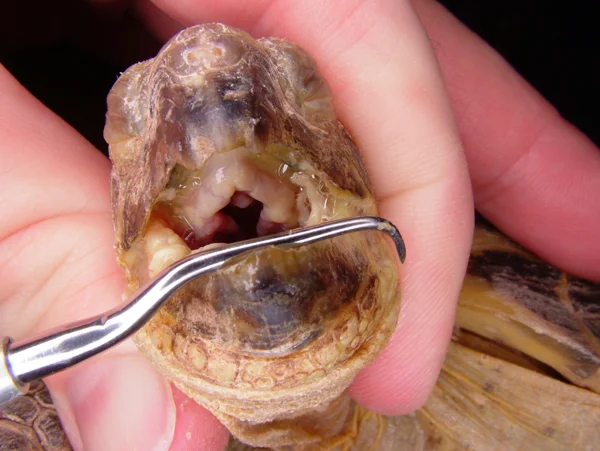All tortoise owners face warnings about the long lifespan of these reptiles.
We need to be aware that they could live for as long as 70 years and may even outlive us.
Therefore, we expect them to be around forever and don’t think about the prospect of tortoise mortality. Yet, tortoises can still develop a range of health problems that cut their life short.
So what should you look out for and what are the signs a tortoise is dying? Difficulty breathing. abnormalities in the shell and a runny nose or irritated eyes are often indicators that there may be an issue with your pet tortoise. These and other signs your tortoise may be sick are covered in more detail below
Another problem in tortoise healthcare is that many people go into tortoise ownership without proper research.
Many are ill-equipped to provide the best diet, environment, and healthcare for these animals.
Then, when problems occur, there is a lack of knowledge about tortoise anatomy and physiology which makes it difficult to keep them healthy.
So, can we look for signs a tortoise is dying and what do those signs mean?
Why is it so difficult to know if a tortoise is healthy, unhealthy, or even if it is dead?
It isn’t uncommon for tortoise owners to find their tortoise in an unresponsive state and not know if they are dead or not. There are two main reasons for this:
- Tortoise physiology and behavior are so much different from that of cats or dogs
- They can go into a state of hibernation
Dogs and cats are pretty good at telling us when something is wrong.
Their behavior changes, they can try and vocalize their problems and they exhibit familiar symptoms.
Warm-blooded mammals show signs of old age fatigue, pain, and illness that are recognizable. We can feel when they get cold and hear when breathing is labored.
This isn’t the case with tortoises. They are reptiles, so are already cold-blooded.
We can’t see them breathe in the same way as other animals. They also don’t have the expressions and vocalizations to communicate with us.
The problem of hibernation is a big one for novice tortoise owners. Those that don’t understand the process see their animals in a state of torpor and fear the worst.
The animals don’t move, don’t respond, and don’t appear to be breathing. But, there is a chance that you have tried to wake them too early.
They need to come out of hibernation themselves. The last thing you want is to bury your pet alive by mistake.
So, what can we look out for when trying to decide if a tortoise is unhealthy or dying?
These problems show us why it is so important to understand the anatomy and physiology of a healthy tortoise.
That then allows us to notice changes more easily and spot problems before they become terminal.
A lack of understanding or observation could allow an illness or injury to worsen until it becomes fatal.
Be aware that the following signs don’t necessarily mean that your tortoise is close to death.
Many are signs of illness and other physiological problems that may be treatable with medical intervention.
However, others may be signs of a terminal condition or – if left for too long untreated – could result in the animal’s demise.
10 Signs a Tortoise is Dying or Sick.
1) The shell
This may come as a surprise to some new tortoise owners, but the shell is an important indicator of health.

A healthy tortoise’s shell is smooth and firm with no obvious abnormalities or signs of injury.
You should also see the growth rings forming between the scutes – the individual plates. Any deviation from these norms may suggest an illness or infection.
Also, it should go without saying that any cracks or obvious injuries to the shell should be treated immediately.
These suggest blunt trauma and there may be other damage internally.
A fracture could also invite parasites and infections into the shell.
2) Difficulty Breathing
As was mentioned above, it is harder to notice when a tortoise is breathing normally than it is for a cat or a dog.
However, there are signs to look out for when breathing is abnormal. This includes any audible wheezing or labored breathing.
If you watch your tortoise more closely, you may also see them breathing with their mouth open. This could be the result of respiratory illness or obstruction.
The addition of a nasal discharge could indicate a potentially fatal case of pneumonia.
3) Activity Levels
There are two issues here with activity levels. Some animals can show some weakness or listlessness.
This could come down to a lack of muscle mass or energy caused by dietary issues, deficiencies, or injuries. A critical illness could also rob them of their strength.
Then there are those who either cannot move at all or suffer a loss of function in their rear limbs.
This could be the result of an injury to the limbs or the joints that may have gone unnoticed. The animals may also be experiencing paralysis due to an underlying illness or egg retention.
If untreated, this could lead to other complications.
4) The Tortoise’s Weight
This one can be difficult to determine because you cannot see the flesh body of the animal that well.
However, it is important to maintain a good idea of the animal’s weight to keep track of any weight loss.
They should feel solid and heavy when you pick them up. Animals that are very light and weak could be close to death.
Weight loss could indicate a range of problems from infections to digestive issues.
5) Their Eyes
The eyes are often one of the clearest indicators of a tortoise dying. A dead tortoise tends to exhibit sunken eyes with no sign of life and dullness to them.

The third eyelid may also be more visible. The eyes of a healthy tortoise – by comparison – should be clear and bright. There should also be no sign of discharge or infection.
It is also important to take note of any incidence where a tortoise starts rubbing its eyes or ears with their forelegs.
This is a clear sign of an eye or ear infection that irritates or pains them. In some cases, this could be as simple as a minor infection or a vitamin deficiency.
However, they may also have an abscess that you can’t see that could prove deadly if untreated.
6) Their Nose
The health of the nose is similar to that of the eyes.
They should be clear and dry with no unexplained signs of discharge.
If the nose begins weeping or shows mucus then they may have an infection or possibly pneumonia.
7) Their Mouth
The mouths of tortoises should be a healthy pink color when clean of food and liquid.
When was the last time that you looked inside their mouth to check? Take a look and see what color it is.
A pale color could highlight a lack of red blood cells and the development of anemia.


Alternative diagnoses may include a parasitic infection, liver disease, or some form of internal hemorrhaging.
8) Bleeding and Cuts to the Skin or Carapace
If you notice blood or reddening to the skin or the carapace that this is a big red flag – to pardon the pun.
Lesser issues include some form of systemic, fungal, or bacterial infection. However, there is also the risk of shell rot – a subcutaneous ulcerative infection – which is much more serious.
9) Swelling of the Flesh
The flesh around the neck and limbs of the tortoise can take on a puffy appearance.
If this occurs with no other negative effects then you could simply be overfeeding your tortoise.
However, if it is a sudden development, it could be down to renal or pulmonary disease.
10) Their Excrement
The last thing to look at more closely is their excrement and urine.
Do you know when they are both as they should be? The urine should be clear with white urates that are runny. The feces should be firm and dry.
Tell-tale signs of illness are when this is the other way around. Watch out for loose stools but also take note if you see any blood, worms, or parasites.
This could mean digestive issues and infestations.
What Should You do Next?
The first thing to do if you notice any of these issues is to take your tortoise to a vet. They can perform a full examination of the animal and any necessary tests.
From there, you can get a better idea of the prognosis and your next steps. If the tortoise can be saved then you can start treatment.
If not, it might be time to euthanize the animal to stop it from suffering any longer.
In short, is your tortoise dying, sick, or perfectly healthy?
Familiarize yourself with the different checkpoints mentioned above. Look at these parts of the animal’s body regularly so you can notice any changes.
If you see any major changes or dangerous symptoms then they may be signs of your tortoise dying.
Take them to a vet as soon as possible to get the very best treatment and chance of survival. Don’t delay if you have any doubts at all.
